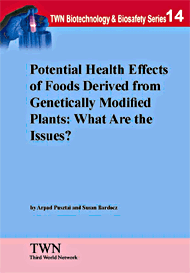Potential Health Effects of Foods Derived from Genetically Modified Plants: What are the Issues?
Hits: 3380
28 June 2011
By Drs Arpad Pusztai and Susan Bardocz. Published by Third World Network, 2011. ISBN 978-967-5414-42-4. 48pp, £6 or free download (www.twnside.org.sg)
 In this handy booklet Arpad Pusztai and Susan Bardocz explain why a framework for the assessment of the safety of GM food is essential.
In this handy booklet Arpad Pusztai and Susan Bardocz explain why a framework for the assessment of the safety of GM food is essential.
Arpad Pusztai is largely responsible for the cautionary approach to GM food. He was the leading scientist at a top nutrition institute appointed by the UK Government in 1996 to set up an independent risk assessment of GM food.
By 1998 Pusztai had discovered that GM potatoes containing an added plant protein caused significant changes to multiple organs and the immune function of healthy, young male rats. No adverse effects were found in the rats fed non-GM potatoes or large amounts of the protein. This could only mean there was something wrong with GM potatoes.
Pusztai’s findings created a furore, resulting in Scotland's Rowett Institute sacking him from his 35-year post. Hounded by the press and legally gagged by his former employer, Pusztai was vindicated when The Lancet published his results in 1999. The Royal Society's former vice-president responded with threats to its editor and it dismissed Pusztai and his colleague, Prof Stanley Ewan’s ‘claims’ as fraud. Why? A Royal Society report published in 1998 praised the potential of GM plants for food use. Four of its co-authors, including former vice-President Sir Brian Heap, were subsequently involved in a Royal Society working group that discredited Pusztai, prompting accusations of bias.
The group shared links with the Roslin Institute, responsible for creating Dolly the Sheep, the GM-produced clone (that died of lung complications) and Biogen, the world's first transnational biotech company. Despite attempts to mislead the public on Pusztai’s experiment, the Royal Society, heavily funded by transnational corporations, has not repeated it.
Pusztai's work is still relevant today and he continues his research in his homeland, Hungary, despite suffering a stress-related illness after his ordeal. Both he and Susan Bardocz were awarded the Stuttgart Peace Prize in 2009.
The results of Pusztai’s GM potato study are reproduced in this booklet and include the disturbing, iconic image comparing the enlarged and distended intestinal cells of a rat fed GM potato for just 10 days against a rat that was not.
To date, all well-designed, GM studies carried out independently of the biotech industry have demonstrated that eating GM foods is anything but safe.
The authors commend Jeffrey Smith (author of Seeds of Deception) for collating the mass of independent studies on the hazards of GM food in his subsequent book Genetic Roulette (www.geneticroulette.com), which provides an ongoing information service where people can learn how to avoid eating GM foods and report any adverse effects.
Smith flags up the dangers from GM food to children, who are generally more susceptible to toxins, allergens and nutritional problems and prone to recurring infections.
However, this booklet concentrates on several important recent studies on GM maize (MON810 and NK603) already approved for use in Europe. It also documents the effects of Monsanto's Roundup Ready (RR) soybeans on animal reproduction.
The results are disturbing, particularly when RR contains the widely available weed killer glyphosate, which has been found in the gut bacteria of humans.
In the USA and Canada, food derived from genetic modification is treated by the Food and Drug Administration (FDA) as 'substantially equivalent' to food derived from conventional crops, which means it passes unlabelled and untested into the human and animal food-chain.
So, why is the word of companies like Monsanto the law? Because the biotech corporations have convinced regulators that there is no ‘credible’ evidence that GM crops damage the environment or harm human and animal health. Throughout the world the data informing the food safety authorities comes from the biotech industry.
Safety studies on GM foods by the biotech industry are seldom published. They simply assume that GM food breaks down rapidly in the body because it does so with simulated digestive juices in a test tube.
GM food is much more complex than this. Pusztai and Bardocz say that digestibility must be tested in the gut, in vivo, to discover how much GM DNA enters the genome of humans and animals once eaten and absorbed into the bloodstream, cells, organs, gut bacteria and the immune system.
The authors stress the issue of antibiotic marker genes and bacterium present in GM DNA passing into the placenta of pregnant women and concerns about the biological consequences of that transfer.
They posit that the next step toward properly assessing the safety of GM food is long-term testing on humans. But, this can only happen after it can be shown that no harm has come to animals in GM feeding trials.
However, there are problems here, too. Human testing usually takes place on healthy young volunteers. This raises questions about the effects on the very young, the old and the ill. For example, 40% of Americans already have gastro-intestinal disorders.
In the absence of industry studies showing that GM is safe, the authors propose a protocol for risk assessment using both toxicological and nutritional methods to test the health benefits of GM and screen for unintended consequences and potentially harmful effects.
Ultimately, Pusztai and Bardocz question whether GM crops are really needed in the first place, especially when the Food and Agriculture Organisation (FAO) say there is sufficient food to feed the world, provided it is properly and evenly distributed.
Sam Burcher holds an MSc in Education for Sustainability and is co-author of Food Futures Now (ISIS, London, 2008)
A version of this article was published by Caduceus Magazine in 2011








